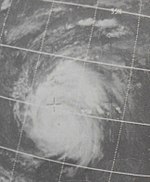1967 Atlantic hurricane season
| 1967 Atlantic hurricane season | |
|---|---|

Season summary map
|
|
| Seasonal boundaries | |
| First system formed | June 10, 1967 |
| Last system dissipated | October 31, 1967 |
| Strongest storm | |
| Name | Beulah |
| • Maximum winds | 160 mph (260 km/h) (1-minute sustained) |
| • Lowest pressure | 923 mbar (hPa; 27.26 inHg) |
| Seasonal statistics | |
| Total depressions | 29 |
| Total storms | 8 |
| Hurricanes | 5 |
| Major hurricanes (Cat. 3+) |
1 |
| Total fatalities | 79 |
| Total damage | $207 million (1967 USD) |
| Category 1 hurricane (SSHWS) | |
| Duration | August 28 – September 4 |
|---|---|
| Peak intensity | 85 mph (140 km/h) (1-min) 982 mbar (hPa) |
| Category 2 hurricane (SSHWS) | |
| Duration | September 5 – September 21 |
|---|---|
| Peak intensity | 110 mph (175 km/h) (1-min) 958 mbar (hPa) |
| Category 5 hurricane (SSHWS) | |
| Duration | September 5 – September 22 |
|---|---|
| Peak intensity | 160 mph (260 km/h) (1-min) 923 mbar (hPa) |
| Category 1 hurricane (SSHWS) | |
| Duration | September 8 – September 21 |
|---|---|
| Peak intensity | 85 mph (140 km/h) (1-min) 973 mbar (hPa) |
| Tropical storm (SSHWS) | |
| Duration | September 26 – October 1 |
|---|---|
| Peak intensity | 60 mph (95 km/h) (1-min) 1000 mbar (hPa) |
| Category 1 hurricane (SSHWS) | |
| Duration | October 1 – October 4 |
|---|---|
| Peak intensity | 85 mph (140 km/h) (1-min) 987 mbar (hPa) |
| Tropical storm (SSHWS) | |
| Duration | October 5 – October 8 |
|---|---|
| Peak intensity | 50 mph (85 km/h) (1-min) 1002 mbar (hPa) |
| Category 1 hurricane (SSHWS) | |
| Duration | October 19 – October 31 |
|---|---|
| Peak intensity | 90 mph (150 km/h) (1-min) 981 mbar (hPa) |
The 1967 Atlantic hurricane season featured the bulk of its activity in September and October, although weaker tropical depressions were observed from June to October. The first depression originated on June 10, and the final storm – Heidi – lost tropical characteristics on October 31. Hurricane Beulah – the strongest storm of the season – was also the most damaging, causing 59 deaths and $207 million in damage (1967 USD) along its 16-day path. Beulah formed on September 5 and soon after crossed southern Martinique into the Caribbean Sea. On the island, it dropped 18.7 in (475 mm) of rainfall in Les Anses-d'Arlet, causing severe flooding. Widespread evacuations occurred along the southern coast of the Dominican Republic due to fears of a repeat of Hurricane Inez from the previous year. After brushing the south coast of Hispaniola, the hurricane weakened and re-intensified, striking the Yucatán Peninsula and later near the United States/Mexico border. There, it caused severe river flooding, killing 34 people in the two countries.
Hurricanes Arlene and Chloe, as well as several tropical depressions, originated from tropical waves that left the coast of Africa. Chloe lasted for 15 days, eventually dissipating over France after wrecking a ship offshore northern Spain, killing 14 people. Hurricane Doria co-existed with Beulah and Chloe, taking an unusual trajectory over the eastern United States; it killed three people in a boating accident offshore New Jersey. In late September, Tropical Storm Edith was a minimal storm that moved through the Lesser Antilles without serious impact. Hurricane Fern killed three people when it struck Mexico north of Tampico. Tropical Storm Ginger existed in the far eastern Atlantic in early October, and Hurricane Heidi stalled over the northern Atlantic Ocean at the end of the month.
The season began on June 1, which was the date when the National Hurricane Center (NHC) activated radar stations across the Caribbean and Gulf of Mexico. The season ended on November 30, which ended the conventional delimitation of the time period when most tropical cyclones form in the Atlantic basin. At the end of the season, NHC director Gordon Dunn retired and was replaced by Robert Simpson. For the first time in 1967, the NHC tracked weaker, developing tropical disturbances, observing that 90% of systems do not develop. Tropical cyclogenesis – the process in which a tropical cyclone develops – resulted mainly from tropical waves, the Intertropical Convergence Zone (ITCZ), and decaying frontal systems. There were 30 tropical waves that exited the west coast of Africa at Dakar, Senegal, of which 14 became tropical depressions. Another 20 tropical disturbances originated offshore the Mid-Atlantic states, and 7 disturbances derived from cold-core lows.
...
Wikipedia















